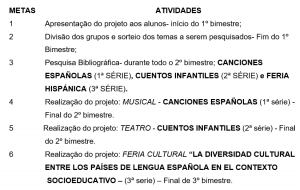ORIGINAL ARTICLE
SOUSA, Clauber Nascimento de [1], MARTINS, Adriana Regina Dantas [2]
SOUSA, Clauber Nascimento de. MARTINS, Adriana Regina Dantas. Analyzing simple past tense through a functional and a formal perspective. Revista Científica Multidisciplinar Núcleo do Conhecimento. Year 07, Ed. 10, Vol. 08, pp. 116-130. October 2022. ISSN:2448-0959, Access link in: https://www.nucleodoconhecimento.com.br/lyrics/analyzing-simple, DOI: 10.32749/nucleodoconhecimento.com.br/lyrics/analyzing-simple
ABSTRACT
This paper is aimed at comparing and presenting two grammar books about simple past tense teaching. One of them is Susan Kesner Bland Intermediate Grammar: From Form to Meaning and Use. And John e Alison Kooistra the power drill, reproducible 70 lessons. In order to do so, we trace the question “what’s the difference between teaching simple past tense in two different approaches?” We intend to bring up the functional and formal approach. Therefore, we inspire this work based on qualitative research in a descriptive method. For achieving our thesis, we cut out simple past tense throughout this paper. Hence, we intend to spot this work based on it. Thus, we concluded that, two grammar books that spread two different approaches: functional and formal. In deep, we found that the formal one is bound to rules, while the functional one is related to contextualized situations. Furthermore, the functional one is adjusted to contemporaneity in the classroom context. While the formal approach overview only on a universal grammar. Formal linguistics is embodied most notably by the work of Noam Chomsky and the paradigm of Generative Grammar. Afterward, we intend to reflect which approach should be better for a classroom and student’s learning.
Keywords: Formalism, Functionalism, Simple past.
1. INTRODUCTION
Language is composed by different theoretical approaches. Furthermore, the history of language teaching is essentially marked by different current of thoughts that have been developed along the years. These differences have been including many things; for example, it includes the role of grammar in teaching. In this period of time, in linguistics the two main linguistic perspectives of analysis are Formalism and Functionalism.
Due to this fact, we can say that these two paradigms defines the two mainly modes of language analysis. Formalism focuses on internal characteristics of language constituents and the relation between them. While, in opposition to American Structuralism, Functionalism presents language not as an isolated phenomenon, but it says that language aims a lot of purposes in which to communicate is only one of them.
We believe it is important for the teacher to know how to point out similarities and differences between these conceptions. Thus, he/she can develop satisfactory information about these conceptions.
Based on that, this paper is aimed at comparing and presenting two grammar books about simple past tense teaching. We intend to solve the question: “what’s the difference between teaching simple past tense in two different approaches? To support this study, we based it on the following authors: Neves (1997); Gebreus (1987); Lock (1996).
We can perceive that the teaching of grammar based on forms is older, while it based on real contextualized dialogues is modern. [3]Studies have been shown that teaching grammar in a functionalist approach is more effective for foreign language teaching (PAIVA; FIGUEIREDO, 2005), in this sense, the teaching of grammar is based on a form which can be considered outdated by some scholars. While real-world-based teaching is an approach that fits with the most current teaching parameters, such as BNCC, for example.
Thus, initially, we will discuss both perspectives. Then we will present the methodological course and after that the discussion of the data. Another positive aspect of this work is to identify which approach could be more efficient in the classroom presently.
2. THE FUNCTIONAL APPROACH
According to Neves (1997), defining Functionalism is hard. Because of that, there are many versions of Functionalism, also linguists that label themselves functionalists. Consequently, Functionalism is composed for linguists that reject Formalism until the ones that have been created a theory. Based on this fact, there are many different models in Functionalism. In deep, Functionalism echoes peculiarities that attend different models. Otherwise, there is a common sense that is found in different functionalism´s perspectives. Hence, it is possible a basic characterization of Functionalist theory of the language.
In a Functionalist perspective, it is important to know how speakers of a certain language communicate efficiently. Hence, Functionalism focuses on communicative competence. As a result, it considers structures of linguistics expressions as function’s configurations. Each function has a different roll in a certain sentence. Hence, functionalists give a functional treatment in the internal organization of the language. According to Givón
All functionalists assume the postulate of non-autonomy: language (and grammar) cannot be described as a standalone system, since the grammar cannot be understood without reference to parameters such as cognition and communication, mental processing, interaction and culture, change and variation, acquisition and development. (GIVÓN, 1995)[4]
This perspective argues that functional grammar includes in its analysis the entire communicative situation: the purpose of the speech, its participants and the discursive context. Gebreus has an interesting view about a functional conception of language. As we can see below.
It can be said that what characterizes the design of functional grammar according to the language-as well as by the Prague school. It is his character not only functional but also dynamic. It is functional because it does not separate linguistic system and its parts of the functions that have to be filled. It is dynamic because it recognizes at the stability of the relation between its structure and its function. This is the dynamic force behind the constant development of the language. (GEBREUS, 1987, p. 129)
In this concept, it is rather work sentences taken from real sources. Because it is worth to take examples in real/daily texts. Because of that, in functionalism is important the role that language plays in speakers live. It considers many universal types of demanding. Gebruers (1987, p.129) reinforces that functional grammar is dynamic. Hence it aims to integrate it in a global theory of real social interaction.
When we say that functional grammar considers the communicative competence it means that functional grammar considers individual’s capacity to codify and to decode expressions. Also, it considers the capacity of interpretation these expressions in a satisfactory interaction system.[5]
Due to this fact, it is related to pragmatics of syntactic-semantic component of language. The most representative’s developments of functionalist’s view of language are related to Prague linguistic circle. In Prague linguistic circle linguistics shown that language permits reaction and reference to extra linguistic reality (NEVES, 1997).
In this perspective, one of the main differences from this point of view is that sentences are communicative units that indicate information. At the same time, it establishes a connection with speech situation and linguistic text. Therefore, Functionalism analyses sentences realized effectively. Interpretation of theses sentences is bound to the context in which it occurs. There are verbal and non-verbal contexts. Choosing this form of teaching is a excellent idea for teachers who want to innovate their classes.
Prague linguistic circle is considered as a functional structuralism; according to Théses (1929) language is a functional system, in which emerges side by side structural (systemic) and functional. Otherwise, the application of the term Functionalism is not only related to Prague linguistic circle. This term is used to refer to anything connected to purpose of linguistics units.
The concept of Functionalism is always related to Prague linguistic circle, but other studies groups emerged from west and east. Additionally, in Prague linguistic circle´s view language is a system of tools to achieve a purpose or a system of systems. In this perspective, each function corresponds to one subsystem. All the subsystems correspond to the phase. In functionalism language is sufficient in itself (NEVES, 1997).
Another difference in the teaching of grammar, is to consider that language has verbal and no verbal contexts. Hence, Functionalism permits negotiation of meaning and it gives students the possibility to participate in a real communicative situation. It is worth to understand that teaching can be a process whereby teachers and students can integrate themselves together. In order to achieve a solid basis that leads us to a better comprehension of English as a second language.
Throughout this work it has been learned that in educational contexts, collaborative learning is an important facilitator of the process of learning. Hence, student-student or teacher-student interaction and negotiation of meaning in the classroom are fundamental for an appropriate development of a foreign language. This principle sparks the concept proposed by Vygotsky, a social psychologist of global expression and recognition, of Zone of Proximal Development – ZPD. As we can see below: “What the student is capable of doing, producing and performing with the help of a teacher (or an expert) in a social context is beyond his/her capacity, exceeding what could if this assistance was not available” (VYGOTSKY, 1978).
Presently, we believe that is crucial to our work firstly to go further in both approaches that we intend to compare. Taking it in consideration, we are going to analyze a the formal approach´s panorama.
2.1. THE FORMAL APPROACH
Otherwise, there is another current of thought that analyses grammar as an autonomic system. This conception is called Formalism. There are dimensional contrast, if we compare the formal teaching of simple past. At first glance, it analyzes the linguist structure, hence it does not care about the language in use. In this position, the analyses of linguistic forms are primary, while functional perspectives are secondary.
Moreover, formalist grammar is related to forms of a systematic structure of a language. On the other hand, Functionalism analyzes systematic relation between function and form. The discrepancy has been reflected in simple past formalists’ grammar exploration. In this variety of teaching grammar language is not contextualized.
Formalism focuses on internal characteristics of language constituents and the relation between them. But it does not focus on constituents and their meaning. Moreover, in Formalism the conception of language is a “system of phases”, “system of sounds”, this way, comparing the directly language to its grammar.
Deeper in this concept – or approach – It considers grammar as a set of rules in which a language is organized. This is a type of grammar named formal. According to the formal concept of grammar what is important is the way language is organized, in this point of view, its grammatical structures and the way they relate to each other rather than the context in which those rules are inserted. In this approach there is a distinction between what is considered grammatical and ungrammatical sentences.
In this approach, a clear distinction is usually made between grammatical (sometimes called well-formed) sentences and ungrammatical sentences. The primary concern is with the forms of grammatical structures and their relationship to one another, rather than their meanings or their uses in different contexts. (LOCK, 1996, p. 1)
In addition to that, this concept of grammar is more interested in working with sentences that have a specific purpose – which is to explain different grammatical rules – rather than working with sentences taken from real sources.
A grammarian interested in this this kind of description will often use for analysis sentences that have been made up to illustrate different grammatical rules rather than sentences drawn from the real world sources. (LOCK, 1996, p. 1)
Afterward, a formal grammar permits specifying a language according to a set of rules of its language. On the other hand, this kind of grammar is not concerned with the meaning of sentences according to the context in which they operate. According to Evans (2007), While formalists are particularly concerned with developing descriptively adequate accounts of linguistic phenomena and with modelling the representation of knowledge of language in the mind.
Based on these referred aspects, one of the tools used for this kind of approach are the Drills, which consist in the repetition of sentences just replacing some words for others. This kind of exercise has no concern in making students think about the way language operates in different contexts: social, cultural or linguistic as well. Hence, it is based on repetition, language grammatical structures are presented as an isolated system.
2.2. THE SIMPLE PAST TENSE
The grammatical topic that we are supposed to describe is the simple past. We use the simple past to express the idea that an action started and finished at a specific time in the past. Otherwise, we may not actually mention the specific time, but we do have one specific time in mind. All regular simple past verbs end in – ed. Otherwise, irregular verbs have a special form.
To form negative statements, use did + not or the contraction didn´t. The main verb is the simple form.
Moreover, the Simple Past can be used with a duration which starts and stops in the past. Indeed the website usingenglish.com describes the definition of simple past as you can see below:
The Past Simple tense, also called the Simple Past, is used for past actions that happened either at a specific time, which can either be given by a time phrase (yesterday, last year, etc.) or understood from the context. Regular Verbs add -ed to the base form, or -d if the verbs ends with -e. Irregular verbs can change In many different ways. The verb form is the same for all persons. (USINGENGLISH.COM, 2017).
On the other hand, the Cambrigde dictionary classifies the simple past as “the form of a verb used to describe an action that happened before the present time and is no longer happening. It is usually made by adding ed.
3. METHODOLOGY
Hence, we intend to compare two different grammar books. One of them is Susan Kesner Bland Intermediate Grammar: From Form to Meaning and Use which consists in the first book of a 2 volumes collection. It focuses on functional grammar. And another one, we can explore the formal approach throughout the reading of John e Alison Kooistra the power drill, reproducible 70 lessons, a grammar book from 1953. Also, we set our work at philology once it explores diachronic factors. As a consequence, we compare our research through different books. These books perform at different dates.
In order to reinforce our work, we decided to set descriptive research attached to a qualitative one. Our work sparks a Hypothetical deductive method. Moreover, it echoes comprehension and interpretation based on determined behavior. Based on these principles, it is stated that our research has an exploratory focus.
At this stage of the research process, participants need to focus on analyzing and interpreting the information that has been gathered . Data analysis, from the action research perspective, involves examination of the data in relation to the potential resolutions to the questions and problems identified. (BRUCE L BERG, 2004, P. 199).
Furthermore, it stimulates thinking about language teaching and on the subject in question. Increasingly, our research helps deepening knowledge already quantified throughout linguist researches. We intend to create a knowledge a satisfactory base. In our research´s type, the participation of a linguist specialist is another key to interpretation of information received and interpret in the best possible way. Even so, we intend to focus our work in a linguist locus.
3.1 RESEARCH CONTEXT
For supporting our work purpose we have firstly analyzed the simple past on Susan Kesner Bland Intermediate Grammar: From Form to Meaning and Use which consists in the first book of a 2 volumes collection. In addition to that, the purpose of this book is to engage a relationship between the grammar and real life language in which students are supposed to encounter. While sometimes it stimulates informal English spoken discourses. Also, it shows the situated language use related to the simple past tense. Concerning texts, this work explores different genders and images in order to situate the readers. Hence, in this book the possibility of interaction is fundamentally holded by context.
Nevertheless, we can see the formal approach throughout the reading of John e Alison Kooistra the power drill, reproducible 70 lessons, a grammar book from 1953 in which the way of analyzing the simple past is completely different. Because of that, the branch of this material is an attempt to model simple past tense in an explicit mechanical point. It wants to model this verb tense knowledge in the student’s mind. In the same way, the goal of this material is to be direct and follow a pather. As a consequence, it lacks imagetic component. Also, this material does not contemplate interreration. Similarly, it does not conceptualize some aspects of the language.
3.2. DATA ANALYSIS: CRITERIA AND METHODS
We can say that these two theoretical paradigms (formal grammar/function grammar) define the two essential modes of language analysis, one based on linguistic form linked to structural units of language and the other one based on the functions that the structures have in determined contexts. We want to look further to know if it is necessary to students only to chain to grammar rules. Or if, they could comprehend structures and communicate by using the concepts of input/output.
Firstly, analyzing the simple past on Susan Kesner Bland Intermediate Grammar: From Form to Meaning and Use which consists in the first book of a 2 volumes collection.
We can found the simple past case in the chapter 3 which is named: Expressing Past Time: The Simple Past, Used to, and Past Continuous. The part that we intend to analyze can be found from page 43 to 73, although in order to understand it as a functional perspective, it is needed to see the whole unit.
4. DISCUSSION OF DATA
For that, we compare these units from the books. Even so, we compare step by step how the books spark the simple past.
4.1 THE FUNCTIONAL APPROACH
On page 43 we can found a preview where students are inserted in a real situation about the use of the simple past. After that, the book shows a simple past´s definition.
From then on, on page 44 the book shows the simple past of regular and irregular verbs. In this part, students are supposed to understand grammatical rules that are required in order to make some grammatical points. As we can see below.
Example 1: the simple past of regular and irregular verbs
| Regular Verbs | Irregular Verbs |
| I worked yesterday | I left yesterday |
Source: The authors (2022).
However, the exercises that follows on the next pages tries to explain this grammar point with some examples. There are some notes bellow them.
Example 2: the simple past of regular and regular verbs
| ● Ex: all regular simple past verbs end in – ed |
Source: The authors (2022).
From then on, we have some examples that aim at forming negative statements, yes/ no questions, short answers, contraction, information questions. At this point it is important to reinforce that even the book been functional, it is important to take account of form. Otherwise, one thing that called our attention was the fact the unit brings the use of spoken form – informal language as we demonstrated below. In the informal conversation, did you sounds more like diadja:
Example 3: the simple past in the formal conversation
| Written form | Spoken form |
| Did you work yesterday? | “Didjawork yesterday?” (spoken only) |
Source: The authors (2022).
The students are challenged to understand these grammatical points clear but in real communicative situations. One interesting point about this book is the exposition of irregular spoken situations. Hence, the book led us not only in what is wrong or write in grammar, but it led us to possible informal spoken use of language according its context. Consequently, this evaluation of spoken form is bound to the idea communicative competence that is related to Hymes (1974) he has mentioned that the idea of social use of the language should be add in traditional process.
Additionally, the book echoes further phonological information and it presents an exercise based on working on pronunciation. Where are presented regular simples past tenses. After, students have to check the correct column according to how the – ed ending is pronounced.
Example 4: exercise based on working on pronunciation
| Simple past verb | Column 1 /t/ | Column 2 /d/ | Column 3 /id/ |
| Walked__________ |
Source: The authors (2022).
After that, the book presents exercises where students can create their own questions based on affirmative sentences. Also, the book presents a reminding exercise where in a real context students have to ask and answer questions in the past tense.
Example 5: exercise based on dialogue
| Ex: 1. Your friend is going to the beach:
( bathing suit ) A: Did you get your bathing suit ? Yes, I did. Or No, I didn´t |
Source: The authors (2022).
Further, we believe that this grammar book works with prediction and it led ways to interaction. Still exploring this fact, it is worthy the values of input:
As you have now seen, interaction also plays a role as the cognitive processes of learners interact with input to which thy pay attention. Input can become implicit, or automatic language, when learners notice specific features of it, compare these features to those of their own output, and integrate the features into their own developing language system. (GASS and SELINKER, 1994; WHITE, 1987).
In this sense, this possibility of dialogue, emerges scholars to communicate. Furthermore, it stimulates them to output the language due to its context. On top of that, this possibility of output accords students self-conscious of language’s use.
4.2 THE FORMAL APPROACH
Otherwise, we can see the formal approach throughout the reading of John e Alison Kooistra the power drill, reproducible 70 lessons, specifically in the simple past´s presentation. As the title suggests, this book is based in drills. One of the tools used for this kind of approach are the Drills, which consist in the repetition of sentences just replacing some words for others. This kind of exercise has no concern in making students think about the way language operates in different contexts: social, cultural or linguistic as well. Since it is based on repetition, language grammatical structures are presented as an isolated system and we understand it as more difficult for the students to make connections with texts and real life contexts.
Which the examples do not make any relation to a context in which students could think about ideas or develop a brainstorm. The examples themselves are used just as models to be repeated. As the title suggests the exercises are based on drills. As consequence, this aspect of formalist grammar is related to forms of a systematic structure of a language. As in the example:
Example 6: exercises are based on drills
| Past | Present | Future |
| I was | I am | I will |
Source: The authors (2022).
Then follows a list of sentences where students are supposed only to rewrite without any example based on a real communicative situation. The book proposes an exercise to students write about themselves, but it does not present any basis to students develop this work.
Example 7: rewrite exercise
| Ex: Finnish these sentences about yourself, using the verb like.
When I was little, __________________________________________ |
Source: The authors (2022).
From then on, at the end of the unit the book continues to bring only stuck exercises. These exercises are only gaps fillers and they do not create any sense of affective filter with students, as well as they do not promote inference, pre – reading, prediction etc.
For this reason, these referred exercises only offers rusty practices that use to be the only way to “memorize” structures of a second language in that time.
Example 8: gap filling exercise
| B. Finish these sentences about yourself, using the verb be
1. Yesterday, I ________________________________________________ (happy? sad? crazy? Tired? Angry? Excited?)
2.Today, I____________________________________________________ (happy? sad? crazy? Tired? Angry? Excited?)
3.Tomorrow, I ______________________________________________ (happy? sad? crazy? Tired? Angry? Excited?)
|
Source: The authors (2022).
Hence we conclude some following information. The formal one takes in consideration forms, verb bases, traditional grammar like gap filling, no affective filter. On the other hand, the functional one reflects on authentic communication, real life context, functions for specific purposes, and affective filters. It is clear that there are significant differences in the teaching of the same grammar point on the books mentioned above. For instance, for beginning students, it can be easy to model tasks, filling gaps and model phases. While for experienced students the funcional ramification is valid to a better understanding of language’s usage.
5. CONCLUSION
To sum up, the two principal theories about language were compared in this work, and then we compare two grammars that explain grammar through these two theoretical perspectives. According to Lopes (2011), we conclude that functionalist’s analyses broken the frontiers of a form- based study. It observes how a determinate structure can change in the moment of a real communicative interaction. In this perspective, the teaching of a language is bound to social interaction activity. Above all, it is different of situation where language is autonomic and its analysis is not related to communicative situations. This theory has also been particularly concerned with modeling language in context. Above all, functional approach can promote a modern way of teaching where students and teacher can get by together in order to achieve a better understanding of a certain language.
On the other hand, the formal approach is distinct from the other one grammar proved it decontextualized. There was no insertion in a linguistic or in a social context; there were only fragments of the language analyzed in accordance with the rules. The formal analysis showed the sentences analyzed separately from a context of use, it does not make students think about the language, it is all about rules.
Based on our principal question, we can affirm that the main difference in grammar teaching is that the functional approach focuses on construction of a discursive, cultural and linguistic context. Hence, it promotes insightful understanding and exploration of language from a functional and meaning-oriented perspective.
Moreover, teachers can decide which of them can be the most appropriate for a certain group of students. In our incision about simple past, we observe that the formal approach in Kooinstra (1953) should be a manner of teaching in the case of beginners student’s. Also, it should works in English for Specific Purposes students. Usually, this public aims at learning only restricts use of the language. While the functional approach in Bland (1996) could act in student’s who desire further information about the language. Hence, it could include student’s of English as a second language and students from elementary school.
Based on that, we decide the criteria of our analyses are to focus on the general structure and proposal taken from the books mentioned before. We do not mean by this that we believe a teacher should be stuck on one concept and he /she cannot choose another one. On the contrary, we believe it is important for the teacher to know both in order to decide which one is better for him/her to use with a certain group of learners. Despite these achievements, we understand that teaching can be a process whereby teachers and students can integrate themselves together. In order to achieve a solid basis that led to a better education system.
REFERENCES
CHOMSKY, N. Aspects of the theory of Syntax. Cambridge, MA: MIT Press, 1965.
CHOMSKY, N. Lectures on Government and Binding. Dordrecht: Foris, 1981.
CHOMSKY, N. The Minimalist Program. Cambridge, MA: MIT Press, 1995.
CAMBRIDGE DICTIONARY. Cambridge University: Cambridge, 2017. Disponível em: http://dictionary.cambridge.org/pt/. Acessed on: 01/25/17.
DEFRANZO, Susan E. What’s the difference between qualitative and quantitative research? SnapSurveys. U.S, Disponível em: https://www.snapsurveys.com/blog/qualitative-vs-quantitative-research/>. Acessed on: 01/25/17.
DENZIN, Norman K. (Ed); LINCOLN, Yvonna S. (Ed). Thousand Oaks. Handbook of qualitative research., CA, US: Sage Publications, Inc, 1994, xii 643 pp.
EVANS, Vyvyan, Zinken, Jörg (Eds.): The cognitive linguistics reader. London: Equinox, 2007, pp. 263-266.
GASS, Susan; SELINKER, L. (Eds.) Language transfer in language learning. Rowley, Massachusetts: Newbury House, 1983.
KOOISTRA, Alison John. The power drill, reproducible 70 lessons. Lewiston, New York: Fb ṕroductions, 1953.
LOCK, Graham. Functional English Grammar: An introduction for Second Language Teachers. New York: Cambridge University Press, 1996, p 1.
LOCK, Graham. Functional English Grammar: An introduction for Second Language Teachers. New York: Cambridge University Press, 1996, n.p.
LOPES, Maria Fabiola Vasconcelos (Org.). Modo e Modalidade: Gramática, discurso e interação. 1. ed. Fortaleza: Editora UFC, 2011, 77-89, v. 1.
NEVES, Maria Helena. A gramática Funcional. São Paulo: Martins Fontes Editora Ltda., 1997, n.p.
PAIVA, V. L. M. O.; FIGUEIREDO, F. Q. O ensino significativo de gramática em aulas de língua inglesa. In: PAIVA, V. L. M. O. (Org.). Práticas de ensino e aprendizagem de inglês com foco na autonomia. Belo Horizonte: Faculdade de Letras da UFMG, 2005. p. 173-188.
USING ENGLISH: the simple past. Disponível em: usingenglish.com. Acessed on: 01/25/17.
VYGOTSKY, L. S. Mind in Society: The Development of Higher Psychological Processes. Cambridge, MA: Harvard University Press, 1978.
APPENDIX – FOOTNOTE REFERENCE
3. Studies show that teaching grammar in a functionalist approach is more effective for foreign language teaching (PAIVA; FIGUEIREDO, 2005), in this sense, the teaching of grammar based on form can be considered, by most scholars, as outdated. ; while teaching based on real situations is an approach that is in line with the most current teaching parameters, such as the BNCC, for example. (our translation).
4. All functionalists assume the postulate of non-autonomy: language (and grammar) cannot be described as an autonomous system, since grammar cannot be understood without reference to parameters such as cognition and communication, mental processing, interaction and culture, change and variation, acquisition and evolution. (Our translation)
5. It can be said that what characterizes the conception of language defended by functional grammar – as well as by the Prague School – is its not only functional but also dynamic character. It is functional because it does not separate the linguistic system and its parts from the functions they have to fulfill, and it is dynamic because it recognizes, in the instability of the relationship between structure and function, the dynamic force behind the constant development of language. (Our translation)
[1] Lato Sensu specialization in English language teaching methodology from the integrated Centro Universitário da Grande Fortaleza. (FGF). Graduated in Portuguese-English Languages from the Universidade Federal do Ceará (UFC).ORCID: 0000-0001-6305-6894.
[2] Advisor. ORCID: 0000-0003-2763-5885.
Sent: August, 2022.
Approved: October, 2022.





